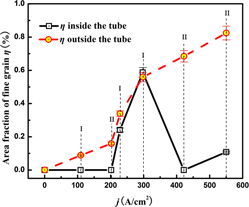Crossref Citations
This article has been cited by the following publications. This list is generated based on data provided by
Crossref.
Zhang, Limin
Li, Ning
Xing, Hui
Zhang, Rong
and
Song, Kaikai
2018.
Effect of Direct Current on Solid-Liquid Interfacial Tension and Wetting Behavior of Ga–In–Sn Alloy Melt on Cu Substrate.
Advances in Condensed Matter Physics,
Vol. 2018,
Issue. ,
p.
1.
Li, Ning
Zhang, Limin
Zhang, Rong
Yin, Pengfei
Xing, Hui
and
Wu, Hongjing
2019.
Research on Grain Refinement in Hypoeutectic Al-Si Alloy during Solidification under an Alternating Electric Current Pulse.
Metals,
Vol. 9,
Issue. 5,
p.
571.
Li, Ning
Zhang, Limin
Zhang, Rong
Yin, Pengfei
Wu, Hongjing
Song, Kaikai
and
Xing, Hui
2019.
The Role of Electric Current-Associated Free Energy and Forced Convection on Grain Refinement in Pure Aluminum under Electropulsing.
Materials,
Vol. 12,
Issue. 23,
p.
3846.
Bobzin, Kirsten
Wietheger, Wolfgang
Hebing, Julian
Zhao, Lidong
Schmidt, Alexander
Iskandar, Riza
and
Mayer, Joachim
2020.
Influence of direct electric current on wetting behavior during brazing.
Frontiers of Mechanical Engineering,
Vol. 15,
Issue. 3,
p.
496.
Zou, Jing
Zhang, Haitao
Qiao, Xiaoyang
Wu, Zibin
Wang, Lei
Li, Yinglong
Nagaumi, Hiromi
Li, Baomian
and
Cui, Jianzhong
2021.
Research on grain refinement and its mechanism of pure aluminum under a novel permanent magnet stirring.
Journal of Materials Research and Technology,
Vol. 15,
Issue. ,
p.
5894.
Balasubramani, Nagasivamuni
Xu, Yanyi
Zhang, Yunhu
Zhai, Qijie
Wang, Gui
StJohn, David
and
Dargusch, Matthew
2021.
Investigating the Grain Refinement Mechanisms of Pulsed Electric Current, Ultrasonic and Melt Stirring Solidification of Pure Aluminium.
JOM,
Vol. 73,
Issue. 12,
p.
3873.
Xu, Yanyi
Zhang, Yunhu
Zheng, Tianqing
Gong, Yongyong
Song, Changjiang
Zheng, Hongxing
and
Zhai, Qijie
2021.
Evolution of melt convection in a liquid metal driven by a pulsed electric current*
.
Chinese Physics B,
Vol. 30,
Issue. 8,
p.
084701.
Shaburova, Nataliya
Krymsky, Valeriy
and
Moghaddam, Ahmad Ostovari
2022.
Theory and Practice of Using Pulsed Electromagnetic Processing of Metal Melts.
Materials,
Vol. 15,
Issue. 3,
p.
1235.
Wang, Wanlin
Yan, Xiong
Zhou, Lejun
Wu, Houfa
and
Zhong, Xiaocan
2023.
Crystallization Behavior of Calcium Silicate-Based Mold Flux Under Electropulsing Treatment with Different Pulse Duty Cycles.
JOM,
Vol. 75,
Issue. 12,
p.
5141.
Balasubramani, Nagasivamuni
Venezuela, Jeffrey
StJohn, David
Wang, Gui
and
Dargusch, Matthew
2023.
A review of the origin of equiaxed grains during solidification under mechanical stirring, vibration, electromagnetic, electric-current, and ultrasonic treatments.
Journal of Materials Science & Technology,
Vol. 144,
Issue. ,
p.
243.
Wang, Wanlin
Yan, Xiong
Zhou, Lejun
Wu, Houfa
Zheng, Qing
and
Zhao, Ru
2023.
Influence of electropulsing treatment on crystallization and structure of calcium silicate-based melt.
Ceramics International,
Vol. 49,
Issue. 3,
p.
4686.
Li, Yanqiang
Jiang, Hongxiang
Sun, Hao
Zhang, Lili
He, Jie
and
Zhao, Jiuzhou
2023.
Microstructure Evolution of the Pb–Al Alloy Solidified Under the Effect of Electric Current Pulses.
Metallurgical and Materials Transactions B,
Vol. 54,
Issue. 5,
p.
2564.





